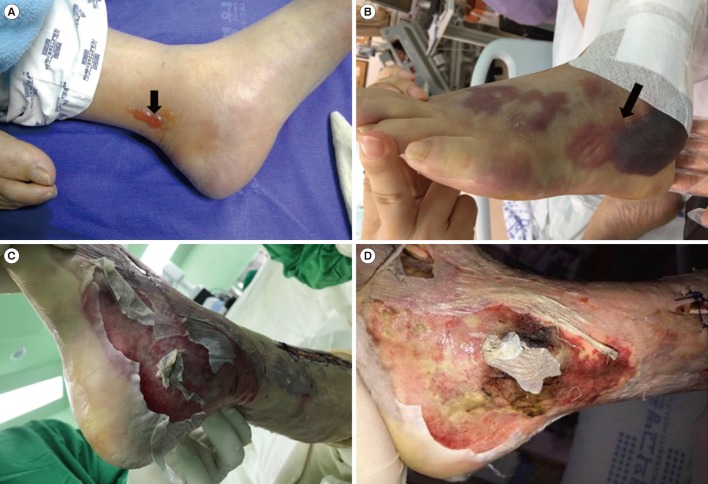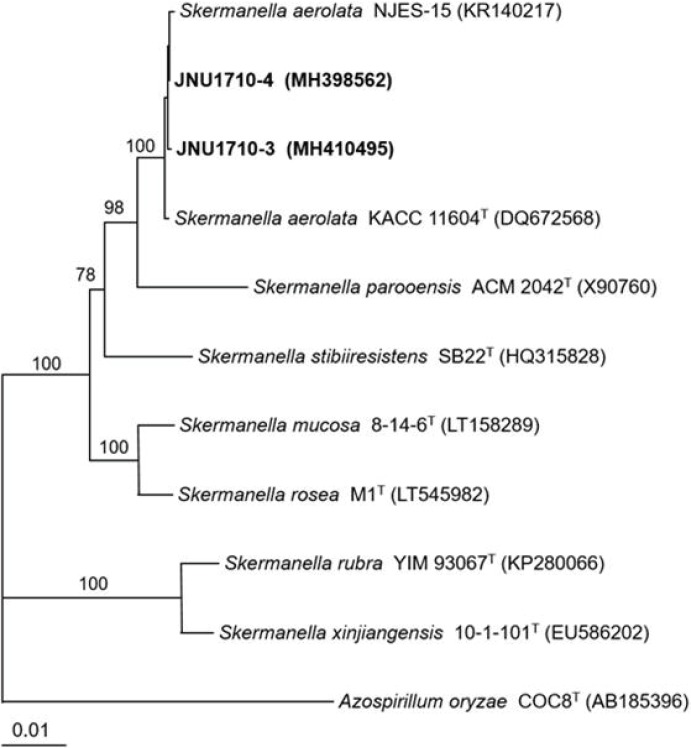Ann Lab Med.
2018 Nov;38(6):604-606. 10.3343/alm.2018.38.6.604.
First Case of Necrotizing Fasciitis Caused by Skermanella aerolata Infection Mimicking Vibrio Sepsis
- Affiliations
-
- 1Department of Infectious Disease, Jeju National University School of Medicine, Jeju, Korea.
- 2Department of Internal Medicine, School of Medicine, Kyungpook National University, Daegu, Korea.
- 3Department of Molecular Cell Biology and Samsung Medical Center, Sungkyunkwan University School of Medicine, Suwon, Korea. ksko@skku.edu
- 4Department of Microbiology and Immunology, Jeju National University School of Medicine, Jeju, Korea.
- KMID: 2429128
- DOI: http://doi.org/10.3343/alm.2018.38.6.604
Abstract
- No abstract available.
MeSH Terms
Figure
Reference
-
1. Sly LI, Stackebrandt E. Description of Skermanella parooensis gen. nov., sp. nov. to accommodate Conglomeromonas largomobilis subsp. parooensis following the transfer of Conglomeromonas largomobilis subsp. largomobilis to the genus Azospirillum. Int J Syst Bacteriol. 1999; 49:541–544.2. Subhash Y, Yoon DE, Lee SS. Skermanella mucosa sp. nov., isolated from crude oil contaminated soil. Antonie van Leeuwenhoek. 2017; 110:1053–1060. PMID: 28501914.3. Kalwasińska A, Felföldi T, Szabó A, Deja-Sikora E, Kosobucki K, Walczak M. Microbial communities associated with the anthropogenic highly alkaline environment of a saline soda lime, Poland. Antonie van Leeuwenhoek. 2017; 110:945–962. PMID: 28382378.4. Park JY, Jeon S, Kim JY, Park M, Kim S. Multiplex real-time polymerase chain reaction assays for simultaneous detection of Vibrio cholera, Vibrio parahaemolyticus, and Vibrio vulnificus. Osong Public Health Res Perspect. 2013; 4:133–139. PMID: 24159544.5. Al Masalma M, Armougom F, Scheld WM, Dufour H, Roche PH, Drancourt M, et al. The expansion of the microbiological spectrum of brain abscess with use of multiple 16S ribosomal DNA sequencing. Clin Infect Dis. 2009; 48:1169–1178. PMID: 19335164.6. Yoon SH, Ha SM, Kwon S, Lim J, Seo H, Chun J. Introducing EzBioCloud: a taxonomically united database of 16S rRNA and whole genome assemblies. Int J Syst Evol Microbiol. 2017; 67:1613–1617. PMID: 28005526.7. Weon HY, Kim BY, Hong SB, Joa JH, Nam SS, Lee KH, et al. Skermanella aerolata sp. nov., isolated from air, and emended description of the genus Skermanella. Int J Syst Evol Microbiol. 2007; 57:1539–1542. PMID: 17625190.8. Wang L, Li J, Yang F, Yaoyao E, Raza W, Huang Q, et al. Application of bioorganic fertilizer significantly increased apple yields and shaped bacterial community structure in orchard soil. Microb Ecol. 2017; 73:404–416. PMID: 27670433.9. Horseman MA, Surani S. A comprehensive review of Vibrio vulnificus: an important cause of severe sepsis and skin and soft-tissue infection. Int J Infect Dis. 2011; 15:e157–e166. PMID: 21177133.10. Lee KH, Heo ST, Kim YR, Pang IC. Isolation of Vibrio vulnificus from seawater and emerging Vibrio vulnificus septicemia on Jeju Island. Infect Chemother. 2014; 46:106–109. PMID: 25024873.
- Full Text Links
- Actions
-
Cited
- CITED
-
- Close
- Share
- Similar articles
-
- A Case of Necrotizing Fasciitis and Severe Sepsis Complicated by Emphysematous Gastritis
- Analysis of Necrotizing Fasciitis Patient by Causative Pathogens
- Puerperal septic shock and necrotizing fasciitis caused by Staphylococcus caprae and Escherichia coli
- Primary Shewanella algae Bacteremia Mimicking Vibrio Septicemia
- Necrotizing fasciitis of head and neck area: 4cases reports



